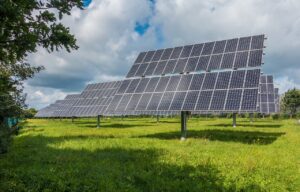Harnessing the sun's power
In the quest for sustainable energy solutions, solar technology has taken centre stage, especially in the environmentally conscious UK market. With the government's current commitment to reducing carbon emissions and the increasing affordability of solar installations, it's no surprise that many are turning to solar power.
However, confusion often arises when differentiating between solar arrays and solar panels. This blog post aims to clarify these terms and their significance in the solar energy landscape.
Solar Cells: the building blocks
At the heart of solar technology lies the solar cell; a device that converts sunlight into electricity. These cells are the fundamental units of any solar energy system, producing 1 to 2 watts of power each. When these cells are connected together, they form a solar module - or panel.
Solar Panels: the power units
A solar panel, or photovoltaic (PV) panel, is a collection of solar cells mounted in a frame. It's the most recognisable component of a solar energy system, often seen on rooftops or in solar farms.
Panels are standardised units, and their power output is determined by the number and efficiency of the solar cells they contain.
For residential or commercial use, a single solar panel can generate a significant amount of electricity, but it's often not enough to meet all the energy needs of a property.
Solar Arrays: the complete system
When multiple solar panels are connected together, they form a solar array. An array is not just a collection of panels; it's an integrated system designed to produce a specific amount of power.
Arrays can be customised, based on the energy requirements of a property and the available space for installation. They can be installed on rooftops, integrated into building designs, or spread across fields to maximise exposure to sunlight.
Where does the UK stand in terms of solar?
The UK's climate might not be the sunniest, but that doesn't diminish the effectiveness of solar installations. Advances in PV technology have made it possible to generate substantial amounts of electricity, even on cloudy days. (Solar power set-up costs are offset over time by the savings on electricity bills and potential earnings from surplus energy fed back into the grid.)
With a significant increase in solar photovoltaic (PV) capacity, from a mere four gigawatt hours in 2004 to an impressive 13.3 terawatt hours in 2022, the UK has demonstrated a strong shift towards sustainable energy production. Moreover, there are currently various incentives for solar energy adoption, making it an attractive option for homeowners and businesses alike.
Solar schemes
There are four major current schemes in operation:
1 - Energy Company Obligation (ECO4) scheme (including LA Flex)
2 - Solar Together
3 - Home Energy Scotland Grant and Loan scheme
4 - The Smart Export Guarantee (SEG)
It is also worth mentioning the Feed-in Tariff, which encouraged investments in solar technology by guaranteeing payments for electricity generated. Although this scheme ended in March 2019, its impact on the proliferation of solar installations across the country was substantial.
Zero VAT on Solar
Under the government’s green incentives, selected energy-saving materials and equipment (including solar panels) qualify for a reduced VAT (Value Added Tax) rate. While typically sitting at 20 per cent, for energy-saving goods and services, it will be set at 0 per cent until 31 March 2027. This applies to both the supply and installation of solar panels in England, Scotland and Wales.
Whether you are thinking of choosing a solar panel or a solar array, it's PRL's expert opinion that solar energy can be a powerful ally in the UK's journey towards a greener future.
Carl Dodd, Property Revolutions Ltd.


